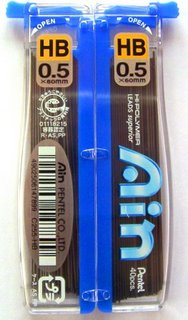At 10am on Wednesday 23 December 1953 the S.S Gothic berthed at the port of Auckland, and our monarch, ‘Elizabeth the Second, By the Grace of God, Queen of New Zealand and Her other Realms and Territories, Head of the Commonwealth, Defender of the Faith’, stepped onto New Zealand soil, the first and only reigning monarch to ever do so.
The crowds went wild!
Just like at Coronation time, it was a good time to be in the souvenir business, and many a souvenir pen and pencil was sold. Unfortunately it seems that most of them were not exactly the good stuff. Rather they were just the ordinary everyday stuff with “Royal Tour” or something similar printed on them. I’ve got a couple of examples.
 First is this short pencil (12cm, 4 ¾’’) that has a jewelled crown on top. You twist the tip to propel the lead. Printed on the body in gold is a small crown and ‘H.M. Queen Elizabeth II, New Zealand 1953-54”. This pencils not in good shape. The printing has faded or rubbed off, the plating is all brassed, etc.
First is this short pencil (12cm, 4 ¾’’) that has a jewelled crown on top. You twist the tip to propel the lead. Printed on the body in gold is a small crown and ‘H.M. Queen Elizabeth II, New Zealand 1953-54”. This pencils not in good shape. The printing has faded or rubbed off, the plating is all brassed, etc.Just in case you are confused by the title, “Queen of New Zealand”, thinking she is Queen of England or something similar, well yes she is, but the various countries that she is Queen of all have their own separate legislation such that she is their Queen independently of the others. Thus she is Queen of Australia, Queen of The Bahamas, Queen of Canada, etc all as separate independent titles. I believe that things are all aligned these days, but back in the 1980’s I recall reading that some countries had human rights and other anti-discrimination legislation such that theoretically the laws of succession were a little bit tricky. However since The Queens oldest child is a male and his oldest child is a male there’s no problem, but if her oldest child had been a daughter, and Elizabeth passed on back in the 1980’s, then some countries could possibly have recognised the daughter as the new monarch and others would have recognised the son as monarch….complicated.

 I also have this great three colour pencil, by Everite, and it’s in “as new” condition. It really is a big pencil, as you can see by comparison to the Dixon Ticonderoga Black wooden pencil. A veritable super-size me whopper, some 20cm (8 inches) long. There is a little crown on top and “N.Z. Royal Tour 1953-54” is printed on the body. Like the others you twist the tip to advance the lead.
I also have this great three colour pencil, by Everite, and it’s in “as new” condition. It really is a big pencil, as you can see by comparison to the Dixon Ticonderoga Black wooden pencil. A veritable super-size me whopper, some 20cm (8 inches) long. There is a little crown on top and “N.Z. Royal Tour 1953-54” is printed on the body. Like the others you twist the tip to advance the lead. The really neat thing about this pencil is that the three sections unscrew to become three separate little pencils, each with a different coloured lead – graphite in the white one, blue in the blue and red in the red one. Awesome.
The really neat thing about this pencil is that the three sections unscrew to become three separate little pencils, each with a different coloured lead – graphite in the white one, blue in the blue and red in the red one. Awesome. Trivia: If you have really good eyesight, you will see that on the $20 note in the photo above, the signature to the left of Her Majesty is that of Donald T Brash, Governor of the Reserve Bank of New Zealand. Dr Brash was the respected Governor of the Reserve Bank from 1988 to 2002, serving under Governments from both sides of the political fence. In 2002 he resigned and ran for Parliament as a National Party candidate. Then followed a meteoric rise through the ranks and he became the leader of the National Party, which narrowly lost our recent elections. So, the currency of New Zealand is guaranteed by the Leader of The Opposition! There can’t be too many countries that can make that claim.
Trivia: If you have really good eyesight, you will see that on the $20 note in the photo above, the signature to the left of Her Majesty is that of Donald T Brash, Governor of the Reserve Bank of New Zealand. Dr Brash was the respected Governor of the Reserve Bank from 1988 to 2002, serving under Governments from both sides of the political fence. In 2002 he resigned and ran for Parliament as a National Party candidate. Then followed a meteoric rise through the ranks and he became the leader of the National Party, which narrowly lost our recent elections. So, the currency of New Zealand is guaranteed by the Leader of The Opposition! There can’t be too many countries that can make that claim.Personal Trivia: Now even though I’ve written this posting about the Royal Tour, I’m not really a Monarchist. I guess I’m fairly “neutral”, like most New Zealanders. I wasn’t around for the 53 tour but I asked my parents if they went to any of the parades or events for Her Majesty. They weren’t able to make it to the parades, but recalled that it was a very big event at the time, and told me how beneficial the tour was for our family. At the time, my father’s father was the maintenance manager for a small hotel chain and Her Majesty was going to stay at one of the company’s hotels. The tour was of course the very first time a monarch had ever come to New Zealand, and no expense would be spared, the hotel had to be totally redecorated. It had actually only just been redecorated a few months previously, but everything had to be ripped out and replaced so it was totally brand new for the Queen. At the time my father and mother were newly-weds and struggling to build a house in their spare time. There were still some post-war restrictions in place, and many building materials were in short supply. So many as-new carpets and fittings removed from that recently redecorated hotel ended up in our house, and in particular we got a brand new “throne” for the smallest room in the house. Porcelain fit for Royalty!
ON HOLD. I wish you all well for the holiday season, and trust that next year will find you happy, healthy and wise. This blog will be on hold for the summer holidays. I will think of those of you who are having a ‘White Christmas’ with snow, as we fry up Christmas lunch on the BBQ and sink a few cold beers down here in the southern summer. Also spare a thought for our Australian cousins across the other side of the Tasman Sea. The bush fires are so bad that New Zealand fire-fighters are having to go over and help out.
All the best, Ciao!
Back in mid January.
Footnote: I actually prepared this posting a few weeks ago, and just to stuff up my trivia, Dr Brash has since resigned from politics. Caught in a bit of a scandal.



 Actually they call it a document clip, a reference to how you can clip it to a thick sheaf of papers. It is a powerful spring loaded clip that will grasp about 15 sheets. Pentel advertise this pencil in their drafting section rather than general section. To me the document clip implies a general office or writing type pencil, but the name, the look and the features are very draughting or graphic art orientated, so perhaps they are aiming for a sort of cross-over pencil; general office and technical work?
Actually they call it a document clip, a reference to how you can clip it to a thick sheaf of papers. It is a powerful spring loaded clip that will grasp about 15 sheets. Pentel advertise this pencil in their drafting section rather than general section. To me the document clip implies a general office or writing type pencil, but the name, the look and the features are very draughting or graphic art orientated, so perhaps they are aiming for a sort of cross-over pencil; general office and technical work?


 Printed in black on the body is “GRAPHGEAR 1000 Pentel PG1015 Japan 6C .5” so you get the full story! Overall I would say this mechanical pencil is built to last, to give you many years of solid reliable performance, but I’m not sure I would recommend it as a general writing pencil. I think it’s more suited to being a technical pencil that also does a bit of general office work.
Printed in black on the body is “GRAPHGEAR 1000 Pentel PG1015 Japan 6C .5” so you get the full story! Overall I would say this mechanical pencil is built to last, to give you many years of solid reliable performance, but I’m not sure I would recommend it as a general writing pencil. I think it’s more suited to being a technical pencil that also does a bit of general office work.

 When you hold the Ohto APS-280E in your hand it really feels like a wooden pencil.
When you hold the Ohto APS-280E in your hand it really feels like a wooden pencil. 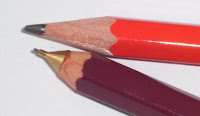


 At first glance the EFAmatic looks like a wooden pencil, but then you quickly pick up on the fact that it’s actually plastic.
At first glance the EFAmatic looks like a wooden pencil, but then you quickly pick up on the fact that it’s actually plastic. 


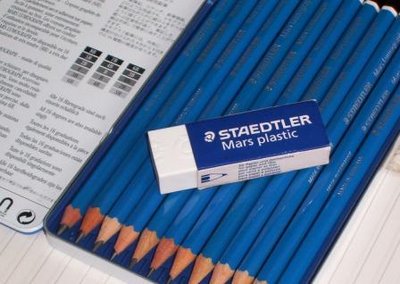
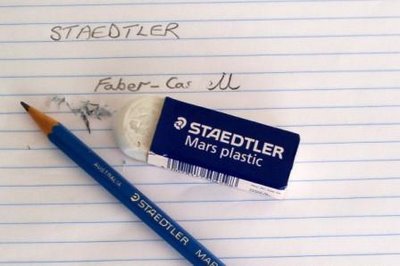 It is a reasonably large eraser which has some good and bad points. On the good side, you can get a firm grip on it which makes things easy if you have a lot of erasing to do, and you can erase an awful lot before you will need to buy a new one. So there’s slightly less need to panic during your exam when you suddenly realise you have to rub out half your wonderful design. On the bad side, whilst it starts out with nice square edges and a square end, you can’t really keep a sharp edge or fine point on this eraser so it is a bit of a blunt instrument. You definitely need an erasing shield if you have some fine erasing to do. Of course chopping the rounded end off the eraser is an option, and I have resorted to this every now and then.
It is a reasonably large eraser which has some good and bad points. On the good side, you can get a firm grip on it which makes things easy if you have a lot of erasing to do, and you can erase an awful lot before you will need to buy a new one. So there’s slightly less need to panic during your exam when you suddenly realise you have to rub out half your wonderful design. On the bad side, whilst it starts out with nice square edges and a square end, you can’t really keep a sharp edge or fine point on this eraser so it is a bit of a blunt instrument. You definitely need an erasing shield if you have some fine erasing to do. Of course chopping the rounded end off the eraser is an option, and I have resorted to this every now and then.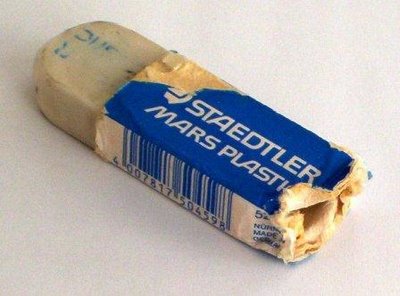 Speaking of the compound, as you erase away, the waste does twist itself up into long strands which are easily removed, just like Staedtler claim. They also claim it is good for removing scuff marks from vinyl floors, marks from light switches and wallpaper, cleaning nail files and a whole lot of other things. I can vouch for the first few – but no idea about the nail file! The compound is relatively odourless – I recall “smelly” erasers being very popular when I was a little fellow at primary school.
Speaking of the compound, as you erase away, the waste does twist itself up into long strands which are easily removed, just like Staedtler claim. They also claim it is good for removing scuff marks from vinyl floors, marks from light switches and wallpaper, cleaning nail files and a whole lot of other things. I can vouch for the first few – but no idea about the nail file! The compound is relatively odourless – I recall “smelly” erasers being very popular when I was a little fellow at primary school.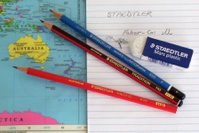
 My converters arrived just as pictured, without any instructions. You can also see they are rather different in shape and length to an ordinary Parker ballpoint refill, so exactly how would they fit? They were advertised as allowing you to convert most Parker type pens to pencils. I easily figured out they are a push-top ratchet mechanism and the top pulls off to allow access to the lead chamber.
My converters arrived just as pictured, without any instructions. You can also see they are rather different in shape and length to an ordinary Parker ballpoint refill, so exactly how would they fit? They were advertised as allowing you to convert most Parker type pens to pencils. I easily figured out they are a push-top ratchet mechanism and the top pulls off to allow access to the lead chamber.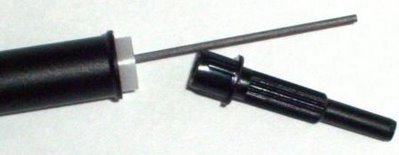 So, first up I grabbed a Parker pen and quickly realised it wasn’t going to work. The spring that fits on the front of the pen refill has to be removed for the converter to fit. My particular Parker’s spring appeared to be permanently affixed inside the pen barrel and I just couldn’t remove it. So then I tried another pen, a non-Parker but one that I could get the spring out of the barrel. But again it was all to no avail. It was actually a twist action pen and I just couldn’t get it to operate the converter mechanism.
So, first up I grabbed a Parker pen and quickly realised it wasn’t going to work. The spring that fits on the front of the pen refill has to be removed for the converter to fit. My particular Parker’s spring appeared to be permanently affixed inside the pen barrel and I just couldn’t remove it. So then I tried another pen, a non-Parker but one that I could get the spring out of the barrel. But again it was all to no avail. It was actually a twist action pen and I just couldn’t get it to operate the converter mechanism. So by slowly chopping small amounts off the top stem of the converter I found a length that made it work, and Voila!
So by slowly chopping small amounts off the top stem of the converter I found a length that made it work, and Voila! It all woks fine as a standard push top ratchet mechanical pencil, but the lead sleeve is not retractable. So overall, not a bad idea, but a little difficult to get to work in the real world. If you had a pen that you really liked and wanted it to be a pencil, then there’s a chance this converter might just work for you.
It all woks fine as a standard push top ratchet mechanical pencil, but the lead sleeve is not retractable. So overall, not a bad idea, but a little difficult to get to work in the real world. If you had a pen that you really liked and wanted it to be a pencil, then there’s a chance this converter might just work for you. 
 One of my recent acquisitions from a bout of eBay madness is a 1948 catalogue from Autopoint. I’ve got a bit of an interest in general history and I like these old catalogues, magazines and so on as they are a glimpse back into the past. I like to compare them to today and think how things have evolved, and I get to pursue two interests at the same time – history and pencils. I bought my 1948 catalogue from a seller in Australia, and it came with a letter from Autopoint to an Australian company that was enquiring about their products. This is the text of the letter:
One of my recent acquisitions from a bout of eBay madness is a 1948 catalogue from Autopoint. I’ve got a bit of an interest in general history and I like these old catalogues, magazines and so on as they are a glimpse back into the past. I like to compare them to today and think how things have evolved, and I get to pursue two interests at the same time – history and pencils. I bought my 1948 catalogue from a seller in Australia, and it came with a letter from Autopoint to an Australian company that was enquiring about their products. This is the text of the letter:




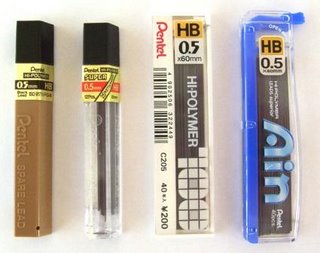
 Well let’s get a few of the technicalities out of the way. Reliving the glory days of The Lead Cup, I put a few sticks of lead to the strength test. It was a clear victory, Ain HB is miles stronger than Hi-Polymer HB, so the cynic in me is wrong, there really must be two different formulations. Right then, what about between the hardness grades of Ain? There was a small but clear difference – as you might suspect, 2H was stronger than 2B.
Well let’s get a few of the technicalities out of the way. Reliving the glory days of The Lead Cup, I put a few sticks of lead to the strength test. It was a clear victory, Ain HB is miles stronger than Hi-Polymer HB, so the cynic in me is wrong, there really must be two different formulations. Right then, what about between the hardness grades of Ain? There was a small but clear difference – as you might suspect, 2H was stronger than 2B.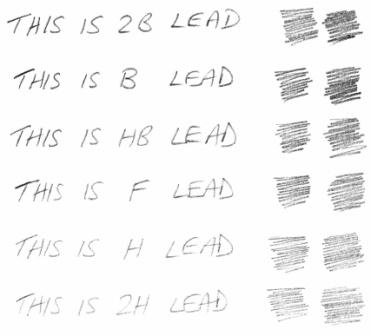 I recently had some difficulty with the diameters of some 0.7mm leads, so since my micrometer was handy I ran it across these 0.5mm leads. Grades 2B, B, HB, F, H, and 2H of Ain were all in the 0.565 to 0.57mm range, and the Hi-Polymer HB was 0.56mm. Strictly speaking, if you were correctly rounding to one decimal place, these are all 0.6mm leads, not 0.5mm.
I recently had some difficulty with the diameters of some 0.7mm leads, so since my micrometer was handy I ran it across these 0.5mm leads. Grades 2B, B, HB, F, H, and 2H of Ain were all in the 0.565 to 0.57mm range, and the Hi-Polymer HB was 0.56mm. Strictly speaking, if you were correctly rounding to one decimal place, these are all 0.6mm leads, not 0.5mm. I must admit I’m rather taken by the Ain packaging. I like the clear sided gently curving container and the bright printed graphics.
I must admit I’m rather taken by the Ain packaging. I like the clear sided gently curving container and the bright printed graphics. 